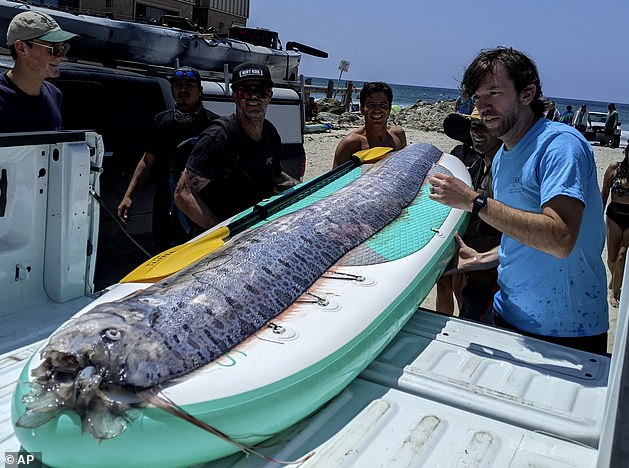- The 12-foot-long oarfish washed up on the coast of San Diego over the weekend.
A rarely seen “doomsday snakefish” was found floating dead on the ocean surface off the coast of San Diego on Wednesday and was brought ashore for study, marine experts said.
The 12-foot-long silvery oarfish was found last weekend by a group of divers and kayakers in La Jolla Cove, north of downtown San Diego, the Scripps Institution of Oceanography said in a statement.
Legend has it that fish are harbingers of earthquakes and other natural disasters, “although no correlation has been proven,” Scripps says, even with the 4.4 magnitude earthquake on Monday centered near the Highland Park neighborhood of Los Angeles.
A group of divers and kayakers in La Jolla Cove found a 12-foot-long oarfish over the weekend.
That quake came shortly after a magnitude 5.2 earthquake on Aug. 6, which was centered near Bakersfield and felt across much of Southern California. according to NBC San Diego.
According to the institution’s fish expert Ben Frable, it is only the 20th time an oarfish has been known to appear in California since 1901.
The oarfish can grow more than 20 feet and normally lives in a deep part of the ocean called the mesopelagic zone, where light cannot reach, according to National Oceanic and Atmospheric Administration.

Swimmers brought the oarfish from La Jolla Cove to shore on a paddleboard
Swimmers brought the oarfish from La Jolla Cove to shore on a paddleboard. They then transferred it to the back of a pickup truck.
“Thanks to the work of these locals, scientists will be able to further study this mysterious species as it becomes part of the Scripps Marine Vertebrate Collection, one of the largest collections of deep-sea fishes in the world,” said a UC San Diego news release.
Scientists there, along with researchers from NOAA’s Southwest Fisheries Science Center, are planning a necropsy on Friday to try to determine the cause of the fish’s death.

